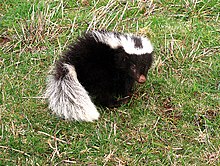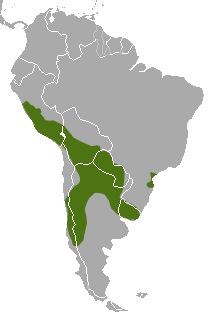| Molina's hog-nosed skunk | |
|---|---|

| |
| Conservation status | |
 Least Concern (IUCN 3.1) | |
| Scientific classification | |
| Domain: | Eukaryota |
| Kingdom: | Animalia |
| Phylum: | Chordata |
| Class: | Mammalia |
| Order: | Carnivora |
| Family: | Mephitidae |
| Genus: | Conepatus |
| Species: | C. chinga |
| Binomial name | |
| Conepatus chinga (Molina, 1782) | |

| |
| Molina's hog-nosed skunk range | |
Molina's hog-nosed skunk, also called the Andes skunk (Conepatus chinga), is a skunk species from South America. It is found in Argentina, Bolivia, Brazil, Chile, Peru, Paraguay, and Uruguay, at elevations up to 5000 m.
Habitat
The Molina's hog-nosed skunk's native range is throughout mid to southern South America, Chile, Peru, northern Argentina, Bolivia, Paraguay, Uruguay, and southern Brazil. The mammal is therefore associated with temperate regions and open areas, mainly described as the Pampas biome and preferring to live in open vegetation, shrub forest and rocky sloped areas.
Population and distribution
Typically they will live alone in an average home range size of about 1.66 individuals/km with some overlapping and about six skunks per 3.5 km. Although living in mostly solitary areas, the skunks will come together temporarily for mating purposes.
Diet
Foraging mainly at night, the skunk is omnivorous, eating birds, small mammals, eggs, insects, leaves, and fruit. The tooth morphology in the Molina's hog-nosed skunk, is different from most mammals in that their teeth are adapted to their omnivorous diet with grinding being the main function of the carnassial apparatus.
Conservation status
The skunk is listed as "least concern" according to the IUCN Red List. The main threats to the skunk are increased habitat destruction and fragmentation from over exploitation of humans and grazing in agriculture. The skunk is also affected by the planning of new roads and road-kills. Due to improper planning, habitat destruction, and fragmentation, the skunk has started living around man-made structures and along fences and buildings.
References
- Emmons, L.; Schiaffini, M.; Schipper, J. (2016). "Conepatus chinga". IUCN Red List of Threatened Species. 2016: e.T41630A45210528. doi:10.2305/IUCN.UK.2016-1.RLTS.T41630A45210528.en. Retrieved 19 November 2021.
- ^ Afflerbaugh, Kevin (2002). "Conepatus chinga". Animal Diversity Web. Retrieved September 10, 2013.
- Kasper, Carlos B.; et al. (2012). "Differential patterns of home-range, net displacement and resting sites use of Conepatus chinga in southern Brazil". Mammalian Biology. 77 (5): 358–362. doi:10.1016/j.mambio.2012.03.006.
- Castillo, D. F.; et al. (2011). "Spatial organization of Molina's hog-nosed skunk (Conepatus chinga) in two landscapes of the Pampas grassland of Argentina". Canadian Journal of Zoology. 89 (3): 229–238. doi:10.1139/Z10-110.
- Peters, Felipe Bortolotto; et al. (April 2011). "Feeding Habits of Molina's Hog-Nosed Skunk, Conepatus Chinga (Carnivora: Mephitidae) In The Extreme South of Brazil". Zoologia (Curitiba). 28 (2): 193. doi:10.1590/S1984-46702011000200006.
The grinding function of the carnassial ap-paratus in skunks (Vaughan et al. 1999) is considered to be appropriate for a diet with a predominance of beetles: small prey that offer lower physical resistance.
- ^ Castillo, Diego F.; et al. (July 2011). "Denning ecology of Molina's hog-nosed skunk in a farmland area in the Pampas grassland of Argentina". Ecological Research. 26 (4). The Ecological Society of Japan: 845–850. doi:10.1007/s11284-011-0855-y. S2CID 35862526.
Increasing habitat destruction and fragmentation has a tremendous influence on mesocarnivore communities.
| Taxon identifiers | |
|---|---|
| Conepatus chinga | |